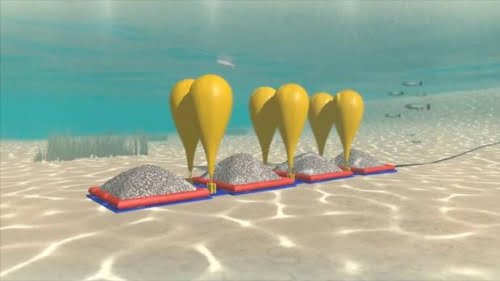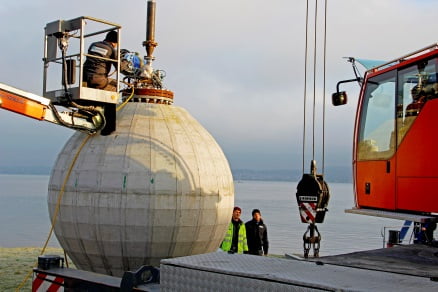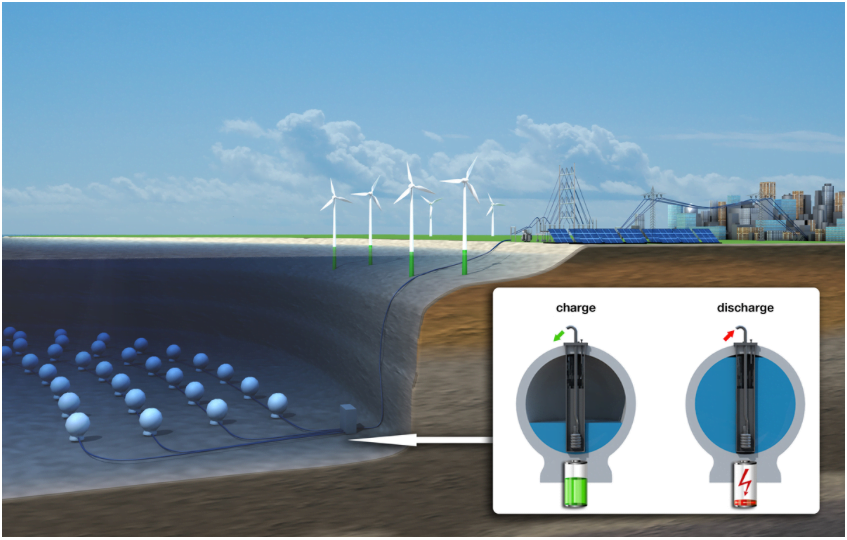A technology brief on the different methods of ocean energy storage
Ocean energy storage systems use the natural properties of the ocean for energy storage. They are not-so-distant cousins to pumped hydro (PHS) and compressed air energy storage (CAES) systems on land. There are two main types of ocean energy storage: underwater compressed air energy storage (UCAES) and underwater pumped hydro storage (UPHS).
UCAES and UPHS differ in two primary ways: the storage vessel and the working fluid. Other than that, the systems are fairly similar and both rely on the weight of the water column at depth to produce force on the working fluid. The round-trip efficiencies for UWCAES and UWPHS are on the order of 70-85%, which is commensurate with regular PHS and CAES. Although there are no full scale commercially-sized systems on the grid, developers are claiming that a full scale system would cost approximately $1,500 to $2,500 per kilowatt, an amount that is almost on par with regular pumped hydro storage. The main concerns with these systems are typically the amount of ballast required, installation, accessibility for maintenance.
There are a few company names to keep on your radar that are working on ocean energy storage. Hydrostor, a Canadian firm, has a pilot project in Lake Ontario rated at approximately 1 MW which will be tested for the next several years. There is also the Stored Energy in the Sea (StEnSEA) project that is being supported by a consortium of German companies, which is also in the process of a small-scale pilot project over the next couple of years.
In an underwater compressed air energy storage (UCAES) system air at pressure is stored inside large pliable bags on the seafloor. Below certain depths, the weight of the water column provides the required pressure to contain the pressurized air inside the bags, preventing them from popping like a balloon. When the stored energy needs to be released, the compressed air inside the bag is is allowed to flow out via a turbine generator which then produces electrical power. To store energy, or charge the system, compressed air is pumped back into the bag.
UCAES devices work best at depths of 400 – 700 meters underwater; this water depth provides the pressure needed for most turbine compressors where compressed air energy storage is typically used.
There are some benefits to UCAES. In regular CAES on land or underground, the compressed air is stored in a reservoir of a fixed volume. As the compressed air is released during energy discharge, the pressure inside the storage chamber will decrease, which gradually reduces the flow to the turbine and produces less power. Underwater, the pressure acting on the bag remains near constant, thereby providing a steady flow of air to the turbine and boosting its efficiency. Of course, storing a giant air bag underwater means limited volume and will require lots of ballast to keep it tethered to the seafloor.

In an underwater pumped hydro storage system seawater is used as the working fluid instead of air. These devices use rigid spheres of steel or concrete that rest on the seafloor that pump surrounding seawater in and out. For example, to discharge the energy stored in the tank, the system allows high-pressure seawater from outside the tank to enter through an opening by passing through a turbine that drives a generator. This high pressure seawater drives the turbine which in turn produces power. To charge the system, the seawater inside the tank is pumped out, creating space inside the chamber in preparation for the next discharge cycle.
These energy storage devices work best for short bursts of power, such as reducing peak loads on the grid, commonly referred to as peak shaving. When designing these systems the ideal design has a concrete wall thickness able to withstand the hydrostatic pressure from the surrounding water column, and also provides enough ballast mass to keep the chamber firmly affixed to the seafloor.


Thanks for subscribing to The Liquid Grid! You’ll receive email updates when new articles are posted.